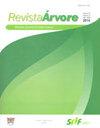TREE DAMAGE AND MISTLETOE IMPACT ON URBAN GREEN AREAS
IF 0.8
4区 农林科学
Q4 FORESTRY
引用次数: 1
Abstract
ABSTRACT Green areas in cities provide several benefits to people, however, several biotic and abiotic agents affects the tree’s health. The main goals of this research were to identify tree damages and to assess the impact of mistletoe on dendrometric variables and the crown condition. Four thousand, seven hundred seventy-five trees were evaluated in 16 green areas of eight Mayoralties in Mexico City; each tree was labeled, and total tree height (Th), diameter at breast height (DBH), damage agents (up to three types), and the crown variables: Live crown ratio (Lcr), Crown dieback (Cdie), Mistletoe severity (Ms) and Crown position (Cpo) were recorded. Of the assessed trees, 3318 presented damage. For the type of damage 1, the mistletoes Cladocolea and Struthanthus showed an average incidence of 42%. For type 2, 20 agents and type 3, 11 were identified. Mechanical wounds, sucking insects, vandalism, and cankers were the most common damages. Based on the Principal Component Analysis (PCA), trees of all diameters and heights were infected, however, Struthanthus was associated with taller and larger diameter trees. Lcr was lower, and Cdie and Ms were higher in infected trees. About Cpo, dominant and codominant trees showed the highest levels of severity by mistletoe. The most affected tree genera were Ulmus and Populus (low Lcr and high Cdie and Ms). Cladocolea was found toward southern Mayoralties, and Struthanthus at the north. It is recommended to assess at least two types of damage on each tree, as this will provide a more complete picture of its health. This is the first study in Mexico on the impact of mistletoe on tree crown variables树木损害和槲寄生对城市绿地的影响
城市绿地为人们提供了许多好处,然而,一些生物和非生物因素影响着树木的健康。本研究的主要目的是鉴定槲寄生对树木的损害,并评估槲寄生对树木密度变量和树冠状况的影响。在墨西哥城8个市长辖区的16个绿地中评估了4,775棵树;对每棵树进行标记,记录总树高(Th)、胸径(DBH)、损伤因子(多达三种类型)和树冠变量:活冠比(Lcr)、树冠枯梢(Cdie)、槲寄生严重程度(Ms)和树冠位置(Cpo)。在评估的树木中,有3318棵树受损。对危害类型1而言,槲寄生和槲寄生的平均发生率为42%。2型共鉴定出20种,3型鉴定出11种。机械损伤、昆虫叮咬、人为破坏和溃烂是最常见的损伤。主成分分析(PCA)结果表明,所有直径和高度的树木都有感染,但以较高和较大直径的树木为主。Lcr较低,Cdie和Ms较高。在Cpo方面,优势树和共优势树以槲寄生的严重程度最高。受影响最大的树种是榆木和杨木(低Lcr,高Cdie和Ms)。克拉多科利亚在马约勒斯的南部,斯特鲁桑托斯在北部。建议对每棵树至少评估两种类型的损害,因为这将提供一个更完整的健康图景。这是墨西哥首次研究槲寄生对树冠变量的影响
本文章由计算机程序翻译,如有差异,请以英文原文为准。
求助全文
约1分钟内获得全文
求助全文
来源期刊

Revista Arvore
FORESTRY-
CiteScore
1.00
自引率
0.00%
发文量
32
审稿时长
4-8 weeks
期刊介绍:
A Revista Árvore é um veículo de comunicação científica da Sociedade de Investigações Florestais – SIF. O jornal é de acesso gratuito, revisado por pares, que publica bimestralmente trabalhos científicos originais no campo da Ciência Florestal. As áreas temáticas para publicação são: Ambiência e Conservação da Natureza, Manejo Florestal, Silvicultura e Tecnologia da Madeira e Utilização de Produtos Florestais.
A política editorial visa manter alta conduta ética em relação à publicação e aos seus funcionários, rigor na qualidade dos artigos científicos, seleção de revisores qualificados, respeito profissional aos autores e processo de tomada de decisão imparcial. A Revista Árvore publica artigos apenas em inglês.
Artigos de revisão podem ser publicados se houver uma discussão relevante resumindo o estado da arte sobre o assunto. A revisão estrita da literatura não é aceita.
 求助内容:
求助内容: 应助结果提醒方式:
应助结果提醒方式:


